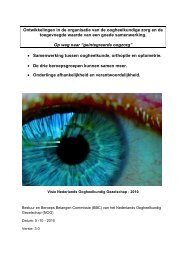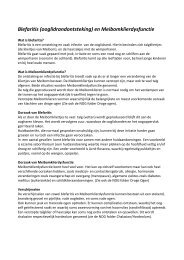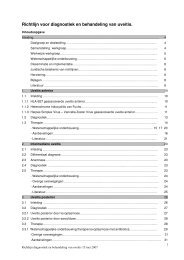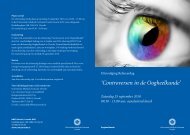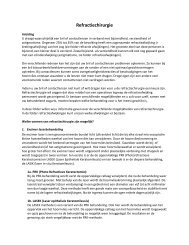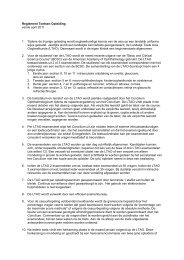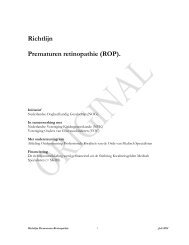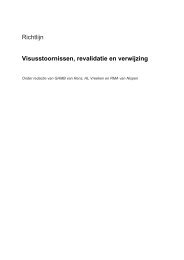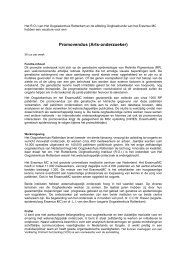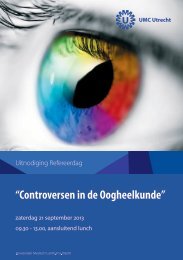terminology and guidelines for glaucoma ii - Kwaliteitskoepel
terminology and guidelines for glaucoma ii - Kwaliteitskoepel
terminology and guidelines for glaucoma ii - Kwaliteitskoepel
You also want an ePaper? Increase the reach of your titles
YUMPU automatically turns print PDFs into web optimized ePapers that Google loves.
2.5 - SECONDARY ANGLE-CLOSURE GLAUCOMAS<br />
Angle-closure <strong>glaucoma</strong>s are clinically divided into the acute <strong>and</strong> chronic <strong>for</strong>ms. The pathogenesis is however many<br />
fold <strong>and</strong> varies according to the underlying condition. By definition, in acute angle-closure, the chamber angle is closed<br />
by iridocorneal apposition that can be reversed, whereas in chronic secondary angle-closure, the angle-closure is<br />
irreversible due to peripheral anterior synechiae.<br />
2.5.1 - SECONDARY ANGLE-CLOSURE GLAUCOMAS WITH PUPILLARY BLOCK<br />
Etiology: The following is a limited list of other etiology <strong>for</strong> relative or absolute pupillary block:<br />
Swollen lens (cataract, traumatic cataract)<br />
Anterior lens dislocation (trauma, zonular laxity; Weil-Marchesani’s syndrome, Marfans’s syndrome etc.)<br />
Posterior synechiae, seclusion or occlusion of the pupil<br />
Protruding vitreous face or intravitreal silicone oil in aphakia<br />
Microspherophakia<br />
Miotic-induced pupillary block (also the lens moves <strong>for</strong>ward)<br />
IOL-induced pupillary block (ACL, anteriorly dislocated PCL) 14<br />
Pathomechanism: Pupillary block pushes the iris <strong>for</strong>ward to occlude the angle. In iritis or iridocyclitis, the development<br />
of posterior synechiae may lead to absolute pupillary block with consequent <strong>for</strong>ward bowing of the iris or “iris<br />
bombé”. Acute secondary angle-closure <strong>glaucoma</strong> may result.<br />
Features:<br />
IOP > 21 mmHg<br />
Disc features compatible with <strong>glaucoma</strong><br />
2.5.2 - SECONDARY ANGLE-CLOSURE GLAUCOMA WITH ANTERIOR “PULLING” MECHANISM WITHOUT<br />
PUPILLARY BLOCK<br />
Etiology:<br />
Neovascular <strong>glaucoma</strong> where the iridotrabecular fibrovascular membrane is induced by ocular microvascular<br />
disease<br />
Iridocorneal Endothelial (I.C.E.) Syndrome, with progressive endothelial membrane <strong>for</strong>mation <strong>and</strong> progressive<br />
iridotrabecular adhesion<br />
Peripheral anterior synechiae, due to prolonged primary angle-closure <strong>glaucoma</strong>; this is theoretically a primary<br />
<strong>glaucoma</strong>.<br />
Epithelial <strong>and</strong> fibrous ingrowth after anterior segment surgery or penetrating trauma<br />
Inflammatory membrane<br />
After argon laser trabeculoplasty (ALT), early <strong>and</strong> late peripheral anterior synechiae <strong>and</strong> endothelial membrane<br />
covering the trabecular meshwork<br />
Aniridia<br />
Endothelial Posterior polymorphous dystrophy<br />
Pathomechanism: The trabecular meshwork is obstructed by iris tissue or a membrane. The iris <strong>and</strong>/or a membrane<br />
is progressively pulled <strong>for</strong>ward to occlude the angle.<br />
Features:<br />
IOP > 21 mmHg<br />
Disc features compatible with <strong>glaucoma</strong><br />
Ch. 2 - 18 EGS



